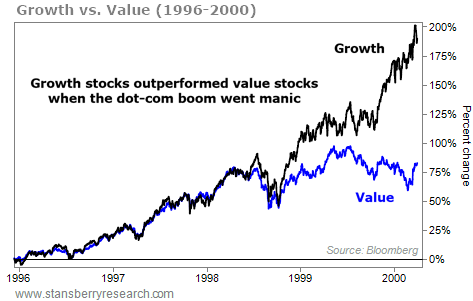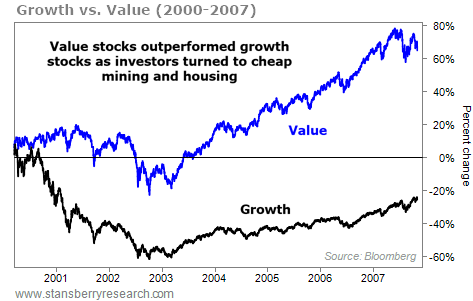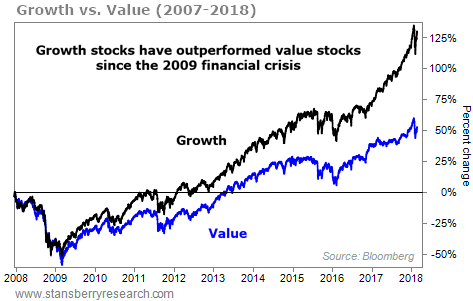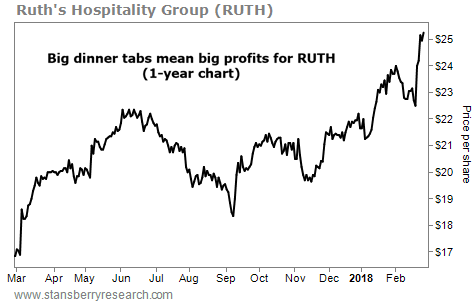| Home | About Us | Resources | Archive | Free Reports | Market Window |
|
Steve's note: I've said it before... This isn't what a top feels like. I expect big gains in stocks before we see a peak. But the "Melt Up" will end eventually. And my colleague Dan Ferris believes that when it happens, one classic investing model will see a return to glory. Today, he explains why, and why it could mean new opportunities for investors...
This Profitable Investing Strategy Is About to Make a ComebackBy
Wednesday, February 28, 2018
I've warned about the ongoing stock market mania since May last year.
And if you've ever wondered what comes after the mania and its inevitable crash, this is the answer...
I believe we're about to see an extended period in which buying good businesses trading at historically cheap valuations – "value stocks" – results in much higher returns than buying fast-growing businesses trading at high valuations – "growth stocks."
Today, I'll explain more about this idea – and why the Golden Age of Value Investing has finally dawned...
The market cycles consistently between growth and value. Growth has outperformed since 2009.
But if you look at the stock market's history and developments in certain sectors of the economy today, the signs show that value could soon overpower growth again.
Just look at this comparison of the Russell 3000 Value and Growth Indexes from the dot-com era...
 If you look closely at the chart, you'll see growth outperformed value the whole time, even in the early years of the dot-com boom. When the boom went manic around 1998, growth stocks rocketed higher. This resulted in the single most overvalued moment in U.S. stock market history. (Until recently, perhaps.)
We know what happened next... Technology stocks, telecom stocks, and other Main Street and Wall Street favorites melted down. Many of the survivors – like Internet leader Cisco (CSCO), chipmaker Intel (INTC), telecom behemoth AT&T (T), and troubled industrial giant General Electric (GE) – still haven't seen their share prices return to dot-com era highs. Many companies went to zero.
After the crash, investors ran from tech stocks. They returned to more conservative, value-priced plays in mining, banking, housing, and mortgages. A new crop of value investors was born. The cycle shifted. And value trounced growth...
 So what happened? What set up the outperformance in growth stocks that we've been seeing over the past several years? It was the financial crisis of 2008...
Wall Street turned conservative housing, mortgage, and banking plays into toxic waste through excessive leverage and complex financial schemes like collateralized debt obligations ("CDOs") – "layer cakes" of risky debt securities that blew up in the financial crisis – and credit default swaps ("CDSs"), which were insurance policies on those piles of toxic debt.
Leading up to the collapse, all the mining, housing, mortgages, and other previously cheap and safe opportunities got absurdly expensive. The mania accelerated as individuals locked in cheap mortgage rates for overpriced housing and engaged in "flipping" (buying and selling houses for a quick profit).
We know what happened next... The housing bubble imploded. The biggest economic crisis since the Great Depression nearly destroyed the global financial system. And investors fled the poisonous assets.
Feeling burned by the value plays gone sour in the crisis, investors turned back to technology, including social media, e-commerce, solar power, and electric cars. Growth has outperformed value since 2009...
 We're nearing the end of the growth cycle. And it looks like value is about to take charge once again. Over the long term, value trumps growth. As I wrote to my Stansberry Research colleagues in October...
Investors forget about the power of value strategies and need to rediscover them every 10 years or so. This time is no different. Growth has been in charge since 2009 – the second-longest bull market on record. Based on history, we can expect at least eight years of value outperformance when this growth cycle is done.
This next period could be the Golden Age of Value Investing. And for investors focused on buying great businesses at cheap prices, it could be one of the most profitable times you ever see in the markets.
Good investing,
Dan Ferris
Editor's note: Dan's new No. 1 recommendation could easily return 1,995%... enough to turn a $5,000 stake into $104,750. "If I had to put every penny of my life savings into one company, this would be it," he says. Click here to learn more.
Further Reading:
"Multibaggers take time," Dan says. "If you can't be patient, you can't get rich in stocks." To learn more about how a long-term, value-focused approach can give you a competitive edge in the markets, check out his essay: Think Like a Business Owner, Not Like a Trader.
"Stocks are super-expensive right now," Dan writes. In this four-part series, he offers his view of this bull market – and reveals how to prepare for the next crash, whenever it strikes. Read the first essay right here: The Key to Surviving a Speculative Mania.
Market NotesIT'S A BULL MARKET IN EXPENSIVE STEAKS Today, we highlight a unique economic "gauge"...
Regular readers know we check in on certain economic "bellwethers" from time to time. Many industries can tell us a lot about how money is flowing in America. We often look for strength in areas like railway companies, ski resorts, and swimming pools to gain insight. Today, this idea is pointing us toward a high-end steakhouse chain...
Ruth's Hospitality Group (RUTH) operates more than 150 Ruth's Chris Steak House restaurants. The company is known for serving high-quality steaks, finished with butter, on a sizzling 500-degree plate. This level of service isn't cheap... So when Ruth's is making money, it's a good gauge of consumer confidence. Last quarter, the company reported a big 15% jump in its sales from last year. And its profits surged 41%.
As you can see in the chart below, shares have ripped higher recently. They're up nearly 50% over the past year... and recently hit a fresh new all-time high. It's more proof that American consumers are confident today...
 |
Recent Articles
|



